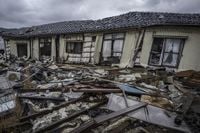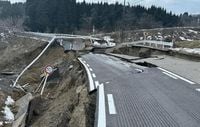Japan is bracing for a potential megathrust earthquake that could have catastrophic consequences, according to a new report released by the Japanese government on March 31, 2025. The report outlines the dire predictions of a magnitude 9 earthquake occurring in the Nankai Trough, which could result in approximately 300,000 fatalities, displace over 12 million people, and lead to economic damages estimated at up to $1.81 trillion, nearly half of the nation's gross domestic product (GDP).
The Nankai Trough, a seismically active region off Japan's Pacific coast, is known for its tectonic activity, where the Philippine Sea Plate converges with the Eurasian Plate. This geological interaction creates significant pressure that could release in the form of a major earthquake every 100 to 150 years, as noted in the report.
Experts estimate an 80% probability of an earthquake with a magnitude between 8 and 9 occurring in this area within the next 30 years. The report emphasizes that the most pessimistic scenario would involve the earthquake striking during a winter night, when many people are at home or commuting, thereby increasing the risk of casualties and complicating rescue efforts.
Shizuoka province is expected to be the hardest hit, with projections indicating that more than 100,000 deaths could occur there alone. Other major urban centers like Tokyo and Osaka are also anticipated to suffer significant impacts. The report highlights that the estimated economic losses have risen from previous forecasts, with inflation and updated assessments of tsunami and flooding effects contributing to this increase.
In comparison, last year's alert from the Japanese government raised concerns about the likelihood of a magnitude 9 earthquake, especially following a magnitude 7.1 quake that struck the Nankai Trough region. The earlier warning indicated a "relatively greater chance" of a catastrophic event, which has now been substantiated by this latest report.
In 2011, Japan experienced a devastating magnitude 9 earthquake that triggered a massive tsunami, leading to the collapse of three reactors at the Fukushima Daiichi Nuclear Power Plant and resulting in over 15,000 deaths. The memories of this disaster loom large in the public consciousness, making the latest predictions all the more alarming.
The new report states that if a magnitude 9 earthquake were to occur, about 1% of Japan's population could be directly affected. In adverse conditions, particularly if the quake strikes at night during winter, the fatalities could soar to approximately 298,000, primarily due to the ensuing tsunamis and the collapse of buildings.
As Japan prepares for the possibility of this disaster, the government is urging citizens to take the warnings seriously and to have emergency plans in place. Public awareness campaigns are being ramped up to ensure that residents understand the risks and know how to respond in case of an earthquake.
Moreover, the report has prompted discussions among policymakers and emergency management officials regarding the need for enhanced disaster preparedness and infrastructure resilience. With Japan being one of the most earthquake-prone countries in the world, the stakes are incredibly high.
In light of these findings, the government is expected to allocate more resources towards improving building codes, conducting regular earthquake drills, and investing in early warning systems to mitigate the impact of such disasters. The aim is to reduce loss of life and property damage in the event of a significant seismic event.
While the report paints a grim picture, it also serves as a crucial reminder of the importance of preparedness and community resilience in the face of natural disasters. The Japanese people have shown remarkable strength in overcoming past challenges, and this latest warning underscores the need for continued vigilance and proactive measures.
In conclusion, as Japan stands on the precipice of a potential earthquake crisis, the government and citizens alike must heed these warnings. With lives and livelihoods at stake, the time to prepare is now.







